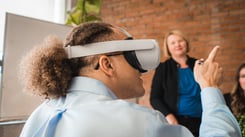Architecture presentations are very unique compared to other presentations in the business world. They are full of visual elements and have technical aspects as well. It’s a dance of design, forward-thinking, and visual appeal. Creating a solid architecture presentation, that both is memorable and satisfying to a client can be quite the task. To help you out we’ve come up with some architecture presentation tips that can help you out.
We’ve done our best to make these architecture presentation tips specific to the architecture practices, rather than just a normal business presentation. Along with that we’ve also included a way to expand on these tips using VR presentation software such as Yulio. As you read through these architecture presentation tips you should get a better understanding of how to make your presentations easier to follow and more memorable. At the same time, you should also see ways to create, enhance, and present your architecture projects with Yulio and VR.
Architecture Presentation Tip 1 – Explain Your Presentation Structure
There are many ways to lead your audience through your architecture project, and the more creative you are at presenting your concept the more memorable your presentation will end up being. We’ve seen presentations that are framed as a walk of the suggested concept. We’ve seen presentations that jump from feature to feature. All are memorable and their deviation from a standard presentation can make your audiences more interested in what you are presenting.
.jpg?width=800&height=546&name=pexels-linkedin-sales-navigator-2182981%20(1).jpg)
However, if your presentation is looking to be unique it might be best to explain your presentation structure prior so your audience can better follow along. There's nothing worse than an audience member who gets “lost” in your presentation and you have to go back and explain yourself again. If your presentation is being presented as a tour, explain the path you are taking, and make sure to check in as you progress through. If you are giving more of a metaphorical journey through your concept, explain so at the beginning and people will be more willing to accept your style.
Fitting VR into Your Structure
If you decide to include VR in your presentation structure, it is probably best to mention it towards the beginning of your presentation. For those who enjoy VR or are open to exploring it. It can build excitement for the first moment when they put on the headset. On the other hand, if someone is VR adverse (say for claustrophobia or motion sickness reasons) explaining that there is a VR component to the presentation means that you won’t be catching them off guard and gives them an opportunity for them to mention this as a possible issue.
Architecture Presentation Tip 2 – Circle back to your concept
Often when presenting an architecture presentation, you will have a concept that the entire project is built around. That concept can vary wildly, but it always surrounds an idea or thought that was always in mind during your design process. We’ve seen concepts such as “Nature”, or “Open Sky” in presentations. But it can be far more abstract than that.
Make sure this concept is introduced early in your presentation so your audience can keep it in mind, but also make sure to circle back to it regularly throughout your presentation. As you introduce new design elements, renders or sketches, remember to make a connection between them and your concept. Keep your concept in your audience's mind for longer and it is more likely to stick with them after your presentation.
Incorporating Your Concept with VR
When you introduce a VR portion in your presentation, we recommend continuing to circle back to your concept again as your audience explores. This can be done as you guide them through the experience, but you can also use software tools if they are available to you. In Yulio, we allow you to add video, text, image, and audio hotspots to your presentation. In these hotspots, it is a great opportunity to circle back to your concept and keep it in your audience’s mind.
Architecture Presentation Tip 3 - Build Better Understanding Through Visual Continuity
Visuals are the cornerstone of any architectural presentation. Choosing the right visuals means a heightened understanding of your project for your audience. We recommend incorporating forms of visual continuity in your presentation. What we mean by visual continuity is having some visual aspects continue throughout your presentation building on the preexisting knowledge in the audience's mind. Maybe you have a floor plan that continues to get filled out as you travel through your presentation. Or maybe when you introduce new renders you take them from the same angle as your sketches to show the transition.
Visual Continuity in VR
One way to build visual continuity in a VR portion of an architecture presentation is to build up around the viewpoint in VR. What we mean by that is to create a VR experience where from on singular viewpoint you change the environment to show how the building takes shape around them. You can show how the structural elements go up, and then the walls around them, and then a fully finished product. In Yulio this can be done by changing the layers of the scene which changes the environment around the viewer.
Make Your Architecture Presentation Stand out with VR
We hope you now have some new ideas of how to approach your architecture presentation with our tips. By keeping your audience informed of your structure and circling back to your concept, you’re less likely to lose your audience and keep them more engaged with your presentation. And by incorporating some form of visual continuity throughout your presentation you can build a better understanding of your project over the course of your presentation. And by incorporating VR into your presentations you can enhance all these aspects further and make truly memorable architectural presentations.







